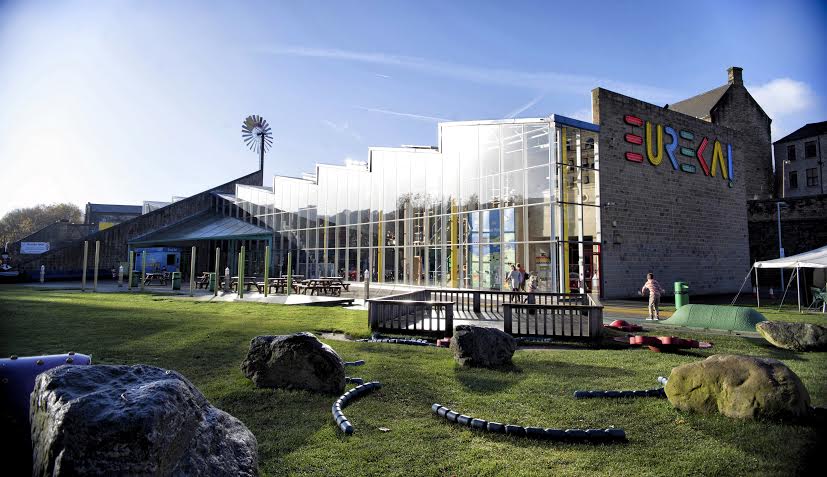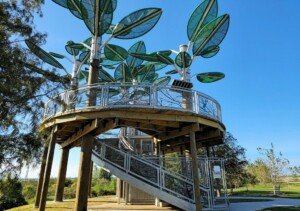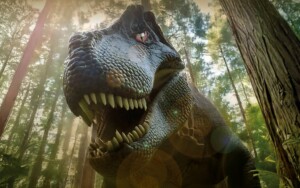Eureka! the award-winning National Children’s Museum in Halifax, West Yorkshire is celebrating unprecedented visitor numbers.
Over 83, 000 people have visited Eureka! during the first quarter of 2014, almost double the number of visitors for the same period in 2013. Visitor numbers started to escalate in the final quarter of 2013 and the trend continued into the early part of this year.
 So what makes this children’s museum, located in Halifax, so increasingly successful? Blooloop spoke to Eureka’s Chief Executive, Leigh-Anne Stradeski (right), about the learning-through-play ethos behind the ground-breaking children’s museum.
So what makes this children’s museum, located in Halifax, so increasingly successful? Blooloop spoke to Eureka’s Chief Executive, Leigh-Anne Stradeski (right), about the learning-through-play ethos behind the ground-breaking children’s museum.
Hooked on Play-Based Learning
Stradeski was Executive Director of Canada’s first children’s museum in London, Ontario and has been the guiding light behind Eureka and its concepts for a decade.
Her move to the world of children’s museums came about when she was VP, Communications at University Hospital in London Ontario and decided she wanted to change her career path and become an Executive Director in the charitable/not-for-profit field in something related to health or education. She completed an MPA on a part-time basis and, while completing her thesis, was approached by the Board of the London Regional Children’s Museum (LRCM), with an offer to complete a review of their operations as they were going through a time of transition and felt they needed some significant changes.
Having submitted a series of recommendations for redevelopment she was asked by the board if she would consider taking on the role of Executive Director on a one year basis to implement her recommendations.
“During my year at LRCM I had the opportunity to implement many new initiatives and to travel extensively through the US visiting other children’s museums. Most importantly I was able to witness first-hand on every single day how much children loved to play and learn through the exhibits and programmes we offered. The more deeply I became involved in the field the more excited I became about the opportunities that children’s museums and play-based learning offered children and families from all walks of life as well as the challenges it presented in terms of remaining relevant, sustainable and visionary.….I was hooked! When the LRCM board asked me to take on the role permanently at the end of the year there was no question in my mind that it was exactly what I wanted to do and where I belonged.”

The Eureka! Philosophy
A unique feature of the Eureka! experience and a key part of its philosophy is the emphasis on undirected exploration. Children are encouraged to take their own journey and to explore where and when they choose rather than being directed by an adult.
Stradeski explains, “We want children to take the lead on their own experience. This enables them to learn at their own pace and pursue their own interests on each and every visit to Eureka! We also recognise and encourage the importance of families playing together as a way of strengthening bonds and helping children and adults alike learn about each other so each of our programmes and galleries is designed with this in mind. Finally, and probably most important, play-based learning at Eureka! is fun….so much fun in fact that children often have no idea that they are actually learning! We sometimes refer to this as ‘learning by stealth’.”
While learning through play is a well-established principle which has been recognised internationally as fundamental to children’s learning for more than a century, it is only recently that the true importance of play in the early years has come to the forefront.
Stradeski points out that the beauty of this is that play comes naturally to children. In fact, in some research used by Play England for the development of their Charter for Play, children said that play is “what they do when they’re not being told what to do by adults”.

There are a whole range of play-types, from imaginative play through object play, rough and tumble play to social play. When playing, children are testing out various hypotheses, taking risks, exploring new concepts, extending their boundaries and identifying their interests and potential – all of which builds self-confidence, resilience, aspiration and social skills. .
“What we deliver at Eureka! builds on children’s natural instinct for play, along with their innate curiosity, to help them learn about themselves and the world around them. We create themed, immersive play-based galleries in which children can explore what it means to be them.”
In the ‘Living and Working Together’ section, for example, children explore their roles as individuals with unique abilities and interests, as parts of a family and members of a broader community.
There is a gallery about the environment which takes children on a journey to different parts of the world and highlights the role we all play in securing a sustainable future – and then there’s an exploration of the science of sound, music and creative performance in SoundSpace. Two galleries are dedicated to the under 5s and there is an outdoor playspace with a sensory garden which introduces the scents, textures, beauty and opportunities of outdoors.

All About Me
The new flagship gallery, All About Me, differs from teaching initiatives on the same subject at other museums and science centres in several key ways. One is the talkative robot ‘Zoom’ which serves as a focal point for the children by first introducing them to the gallery and then having a chat with them later to find out what they’ve learnt during the visit.
The play-based approach to the subject meaning body science is approached holistically and from a range of perspectives which extend beyond biology, anatomy and physiology. This enables the use of themes and a context which is meaningful to children, for instance a doctor and dental surgery where they can bandage up a poorly Mom and Dad or “tsk tsk” as they have to advise Grandpa on improving his brushing and flossing. They can giggle as they climb up the giant nose and find a bogey or explore the track their food takes from the time they put it in their mouth through the digestive system and onwards to its final destination in the Chew to the Poo.
Serious Science
Stradeski points out that while this makes the experience fun and appeals to the child-like sense of humour in all of us, there is a lot of serious science in the gallery and evaluations have shown that children are learning key facts about their bodies and how to take care of them as they go. Sitting around the picnic table and putting together a healthy meal while learning about the role and importance of carbohydrates, fat and protein to health is a key example of this.
As with all activities at Eureka! the whole family gets involved. “It’s not unusual to see three or more generations gathered around the brain area, learning about its significance to all of our sensory experiences. The conversations that begin through the Eureka! visit continue in the car on the way home and are further extended by visiting the microsite allaboutme.org.uk.”

Keeping Pace with New Developments
The team at Eureka! is well aware of the importance of planning for the future, and there are invariably several projects and exhibits on the go at any one time. It’s vital to keep pace with shifting patterns and new developments in children’s interests and learning as well as key trends in the cultural landscape, and advances in science and technology.
“A couple of our key projects at the moment include revisiting Our Global Garden, our environmental gallery which we opened in 2002 and our outdoor space. We’re looking to come up with a concept which reflects the much broader knowledge around issues of global sustainability and exploring how we make these relevant to our audience of children and families. This may involve creating a link with the development of the outdoor space in order to create a seamless indoor/outdoor environmental experience which I’m quite keen on.”
The Eureka! Team is also exploring the “Maker Movement” which has taken the US by storm over the past few years and is growing quickly in the UK. This involves, “…getting children and families actively engaged in tinkering, taking things apart, putting things together and generally making stuff. It might involve woodworking, drawing, sewing, planting and growing, story making, even electronics and technology. We’re really excited about the possibilities this will open up at Eureka! and to kickstart our move into making, our theme for the summer holidays is “Made by Me”, and we’re holding a mini “Maker Faire” as part of this.”

There are outreach events and activities, and opportunities for school groups to experience the successful and popular Museum sleepovers.
The award-winning website www.eureka.org.uk reflects the Eureka! experience online and supports anyone planning a visit. Earlier this year The Eureka! Story was launched on the website, designed to support visitors with autism and other conditions who may be hyper sensitive to sensory input.
Record Breaking
“Our relationship with our visitors doesn’t start and end when they enter and exit the museum, so we’re very  active on social media, which is proving to be an invaluable way to connect with our visitors before, during and after their visits.”
active on social media, which is proving to be an invaluable way to connect with our visitors before, during and after their visits.”
About the record-breaking visitor numbers at the Museum, Stradeski says, “There’s a few things at play here I’d say. Some of it reflects pent up demand to see our new All About Me gallery which opened last March. Generally when a new gallery opens you see visitor numbers rise; in the case of All About Me it’s been a slow burn over several months rather than an immediate surge. This is partly due to the fact that the weather last summer was really good so more people were doing outdoorsy activities rather than visiting museums and cultural attractions whose offer is primarily indoors.
"But our visiting public also know that All About Me is a permanent exhibition not temporary so there was no rush to visit in the summer so a delay until the autumn or winter was logical. And of course, we’ve been marketing extensively with the new gallery, especially using social media and this seems to have had a big impact on our numbers as well as we’re drawing from a broader northern audience than in the past.
"School group attendance has also shot up as a result of the new gallery and its complementary programmes and we’re seeing more and more community groups. So all in all, word seems to be spreading that Eureka! is a fantastic and affordable visitor experience for families and children and I’m absolutely delighted.”

The Importance of Children's Museums
Her feeling is that children’s museums such as Eureka! have a vital role to play in making up for the shortfalls of mainstream education.
“It goes without saying that I favour a more hands-on playful approach in the classroom not only because of my children’s museum background but also based on personal experience with my youngest son whose learning style was definitely better suited to a hands-on approach.
"Study after study has proven the benefits of a hands-on, skill-based approach to learning but the decision makers at high levels choose to ignore this wisdom. What Eureka! tries to do, at the primary level, is bridge the gap of classroom learning with its playful hands-on approach in the hope that those children who visit will link up their learning in the classroom to their museum experience.”
She adds, “Although I wouldn’t propose that all roads to successful learning should be paved with Lego  blocks, my ideal vision for the future would be to have have both primary and secondary schools that successfully combine the best of Eureka! style playful learning with innovative and inspiring classroom teaching. And yes, I do think we’ll get there in the end.”
blocks, my ideal vision for the future would be to have have both primary and secondary schools that successfully combine the best of Eureka! style playful learning with innovative and inspiring classroom teaching. And yes, I do think we’ll get there in the end.”
All images kind courtesy Eureka! the national children's museum.













